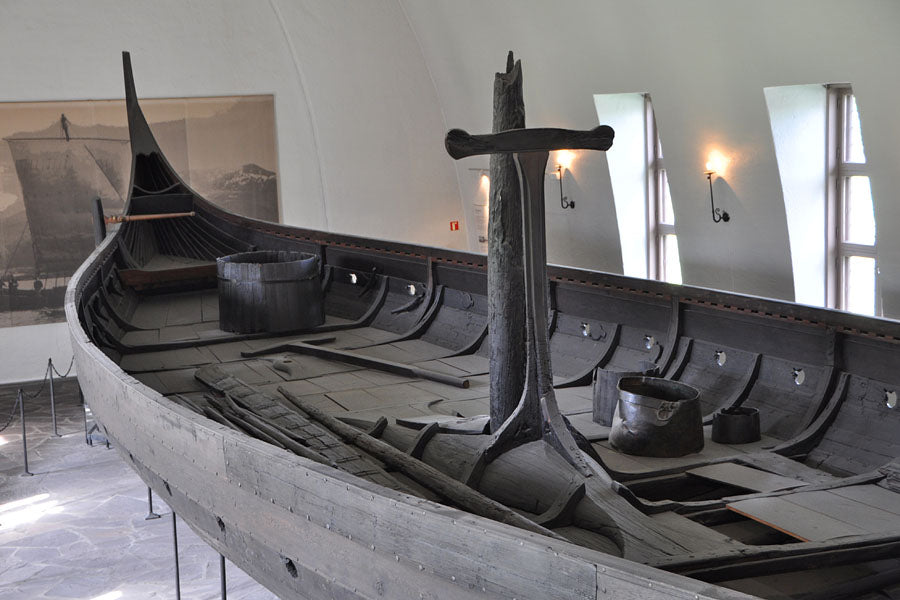Who Was The Man Buried In Viking Gokstad Ship?
The Gokstad ship wasn't merely a Viking ship. It was a burial mound of a great figure in the Viking age. A scientific article in 1883, people knew about the Gokstad ship as the ship of Olaf Geirstad-Alf a petty Viking king in Norway. However, recent research has shown that the ship didn't belong to King Olaf.
After studying the ship, scholars concluded that the ship was built around 890 AD which was the height of the Viking age. And until the year of 901, the ship was buried in the burial mound site in Vestfold, Eastern Norway.
The ship is primarily built with oak with around 24 meters in length (76ft) and 5.2 meters in width (17ft). There are 32 oar holes with 16 holes in each side. The ship is built to carry around 22 oarsmen. With the owner of the ship and the lookout, the crew made up to 35 people. But the real carrying capacity of the Gokstad ship was 70 men with some of their equipment. The Gokstad ship was so fast and flexible that it could be used for trades and raids.
-
See more: What Inside the Oseberg Ship?
What were inside this Gokstad Viking Mound Site?
The numbers of each item inside the Gokstad Viking Mound astonished the archaeologists. There were up to 64 shields painted in yellow and black. The shields were arrayed above the hulls of the ship.
The burial chamber was found later. Inside the chamber, everything was well decorated though the power of time and dust destroyed a lot of them. The walls were decorated with beautifully woven carpets. Many objects were also found. We don't really know about the meaning of each items but many of them were horns, fish hooks, lead, bronze, kitchenware, six beds, tents, smaller boats, etc. Animals like dogs, horses, peacocks were also buried with a vast number.

Depiction of Viking Gokstad burial site
The excavation was carried out in 1880 and there were signs of people entering the Gokstad site before the archaeologists. Of course, those early people were to steal the valuable things inside the burial site. We can know it because there is an absence of the valuable things in the Gokstad mound. Only the wealthy or the noble would afford and deserve such luxurious burial site. So they must have been buried with precious metals and weapons with them. Because the Vikings believed that metals and weapons buried would follow the dead in their afterlife to help them. The absence of such valuable things obviously indicated the ship burial site was plundered.
The skeleton inside the burial mound
In 2007, Per Holck, a professor at the Institute of Basic Medical Sciences, University of Oslo, examined the skeletons found in the grave. The thorough examination pointed out that the bones belonged to the man who died around his 40s. He was approximately 180cm (~6ft) which was much taller than the average Viking (165 cm/5ft). The man must have experienced a wonderful source of nutrition and trained himself a lot to have a good physique.

A cut in the bone of the man's skeleton inside Gokstad burial site
Professor Per Holck showed there were many cuts in the bones. Five or six different cuts from axe, sword, or knife are still clear: one on each thigh bones, one on the right leg bone, and two or three on the left leg bone.
The man didn't seem to survive these injuries because there were no healing signs. None of the cuts were fatal though. But we cannot exclude the possibility that the man died because of the injury because only parts of the skull were found. So the injuries that caused his dead might be in his head.
In the ancient time, aiming at the leg was a very common technique. Because during the time, the warriors only wore chain for the upper body. So there was hardly any protection for the lower one. This made the legs become vulnerable and easy to be attacked.
The man wasn't King Olaf?
Back in 1887, the anatomy professor Jacob Heiberg published his piece of writing noting that the Gokstad ship belonged to King Olaf. And this has been generally accepted.
Snorri Sturluson mentioned in his writing Heimskringla King’s Sagas that Olaf was a petty king in Vestfold and he mentioned Olaf's brother Halfdan the Black (c. 810 – c. 869 AD). Olaf mentioned was around nineteen years older than his brother so he was probably born around the 800AD. But the ship was buried in 901 half century after Olaf's death, so it wasn't likely that Olaf was buried inside the chamber of Gokstad.
Then who rested in peace in the Gokstad burial?

Gokstad burial site in Vestfold, Eastern Norway
Without a doubt, he must have been a very wealthy and noble person with the high rank in the society. If not, he must have been honourable who devoted his life to serving the King and deserved a luxurious burial site. The ship and the items buried with him indicated this. It wasn't easy to afford a ship for a funeral. But this man was buried with a ship, shields, horses, and beautiful chamber.
The peacocks indicated that the man had an international network. Perhaps the peacock was from a king from other places or it was the award he brought from his raid. In Medieval times in Europe, peacock was a species from Asia that presented the power among kings and the royal family. The origin of the man remains a mystery. He might be a king, a chieftain, an earl or he might be a great Viking warrior of his time.




